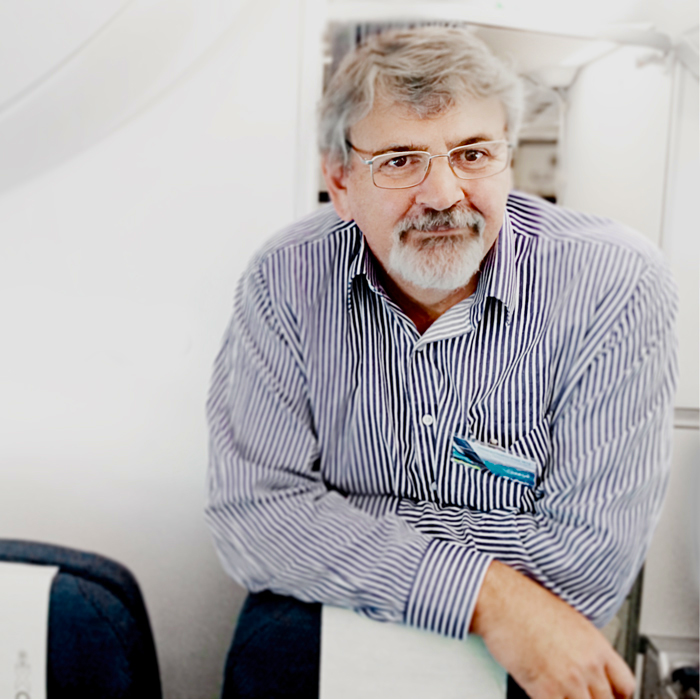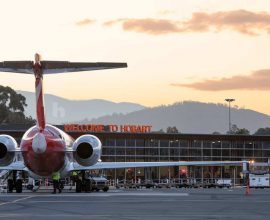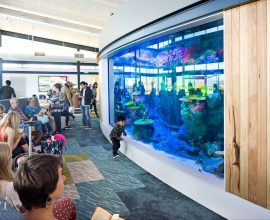Kew farewells NT Airports
Outgoing NT Airports chief executive Ian Kew began his aviation career in a year that more than most earned the lament: “It was the best of times; it was the worst of times”.
It was the dawn of airport privatisation in Australia, an era unfettered by established business practices and ripe for innovation. It was also the year Ansett collapsed and the televised horror of 9/11.
It was 2001, not long after the mid-1998 privatisation of the territory airport group, and investors in the nation’s newly privatised airports were still getting the feel for the industry.
A veteran of energy company Shell, Kew was already familiar with the Top End after working as the company’s Northern Territory manager from 1994 to 1997.
Despite some initial family misgivings, the Kews discovered they loved Darwin, its friendliness and its eclectic mix of people.
“Mitch King was my first chair and they wanted someone who had a strong commercial background, that wasn’t out of a government business and who knew the territory,” he says.
“It was two-and-a-half years after privatisation and it’s been a wonderful journey ever since.
“We didn’t expect to stay that long, but we have and we’re now Territorians.”
The airport chief has no doubts that the post-privatisation era was the best time to be in airports.
He had come from an industry that had “sliced and diced everything over the past 100 years” to one whose course had yet to be charted and whose original investors knew little about the industry.
“They didn’t really understand the opportunities that were available to airports when they were privatised,” he says.
“We’ve had the chance along that 19 years to really do things that have never been done before because the model hadn’t been set.
“As time has gone by, our shareholders think they now know the model and that what works in one airport is going to work in another. But in my time,
At the beginning of 2001, however, Kew was also an airport newcomer despite his good commercial grounding in the tough, demanding and highly professional oil industry.
He had inherited a good team from the Federal Airports Corporation, but the thinking was still coloured by a government worldview that lacked today’s customer focus.
That combination was soon put to the test with the dual tragedies of 9/11 and the traumatic Ansett collapse.
“Ansett was about 45 per cent of our revenue in those days and it was trying time,” Kew recalls.
“I think at that point in time we were within a whisker of banks taking control of our business.”
There was one saving grace: the Federal Government had just commissioned and completed the first Productivity Commission review.
Its draft report recommended replacing the CPI-X price cap regime with commercial negotiations that would allow airports to set their own prices subject to commercial negotiations.
That gave NT Airports the flexibility to review and reset pricing, allowing it to claim one of what would be a string of firsts by becoming the nation’s first airport to move from charges based on aircraft maximum take-off weight to a per passenger system.
Not only did that please new entrant Virgin Blue, but it had the advantage of compelling airlines to tell the airport how any passengers were on their planes.
“From a terminal management understanding of what the opportunities were and from a planning perspective it changed the game,” Kew says.
And although it took until 2005 for passenger numbers to recover, the collapse of Ansett also proved a catalyst that led to another industry-leading move as the airport took control of its terminals.
“That’s given us control over our assets and enabled us to develop a much more comprehensive solution for our airports rather than having large pieces of it locked up by airlines who control what happens there,” says Kew.
The airport chief says one of NT Airport’s strengths has been its ability to deliver commercial deals that were good not just for shareholders but for the development of its airports and for consumers.
And being owned by superannuation funds, says Kew, means that thousands of Australians and Territorians have an interest in the airport.
“We are valuable businesses but also businesses that are truly valuable to the community,” he notes. “We are a key economic driver now.”
While Kew agrees this is true of airports across Australia, he contends it is more so in the Top End where airport growth is an enabler for future growth in the community.
A major terminal expansion program in 2014 doubled Darwin airport’s capacity to cater for future expansion and the investment continues today.
“So even though the economy in the Territory is as tough as I’ve seen it in my time here, our capital program this year is $130 million, which is substantial in Territory terms,” he says. “That’s a demonstration of the faith that the shareholders have in both the airport business and the future of the Territory.”
Nor did the community engagement stop there: NT Airports under Kew fostered substantial links through the arts, charities as well as participation by indigenous and other cultural groups.
He chairs the Darwin Festival and the Darwin Major Business Group, roles aimed at promoting the city while boosting its prosperity and liveability.
He also shepherded the company’s internationally recognised and award-winning solar power projects, an area he believes hold opportunities for all airports.
NT Airports’ involvement with renewables began in the mid-2000s with a hard-fought campaign to get funding under the Federal Government’s Solar Cities program that culminated in grant towards a $2.5 million solar plant at Alice Springs that generated 235 kilowatts of power.
That led to a second project which combined undercover car parking with roof-top solar panels in what was a unique business model at the time.
That meant the airport was generating a megawatt of power and because it operates from dawn-to-dusk meant it was running mainly on renewable energy.
“We came up to Darwin and we’ve built two solar farms, plus we’ve been putting it on our roofs, so we’re generating about 7.5 megawatts of power,” he says. “I think that’s the most of any airport in Australia.”
That generates about 64 per cent of the airport’s power and makes the solar farm the biggest in the Northern Territory. A bonus is that it’s situated on airside land that has no competing uses.
“There are eight hectares of solar power, so it’s a large space, and we have plans for another 10 megawatts which we could export to the grid,” he says. “Plus, every large roof that we build now is getting solar on it.”
The airport is also looking to electrify its ground support equipment and is working with its airline partners to look at innovations such as pooled GSE.
Kew sees it as a great opportunity for the airport that allows it to be at the forefront of the technology and develop a strong renewables business that operates both on and off the airport.
It has given NT Airports expertise in analysing and evaluating solar energy investment decisions as well as putting in place capital and infrastructure.
One potential area of expansion is providing solar-fed battery backup solutions for tenants. Another that particularly excites Kew centres on the development of electric aircraft.
“We know there are two seaters and perhaps four seaters going into commercial production now with a range of 300km or perhaps 400km,” he says.
“We think that will change exponentially and quickly. Places like the Territory will probably benefit more than any other place because of the logistics of supporting conventional aircraft operations in remote locations.
“Airports can really dial themselves into that space.”
Other innovations overseen by Kew include an airport-funded full-service lounge and business centre aimed at promoting business travel and a program to progressively buy back the airport’s conventional fuel infrastructure and open it to competition.
The airport has also developed an extensive commercial property portfolio, including a 350-room airport hotel that was ground-breaking at the time.
“We developed a strong commercial property portfolio now, $300 million plus in value, which really is important for diversifying the revenue stream and de-risking the business,” he says.
Commercial property development and management is another area of expertise Kew believes can be used off airport to expand existing business models, particularly as land on leases fills.
He says airports have teams who know how to invest in, develop, run and maintain property.
“Why would we not do the same on the other side of the road as we do on our side of the road?” he asks.
“Why don’t we take our commercial property development expertise off airport? Why aren’t we building solar power stations off airport?”
Kew concedes this requires a real change of mindset for shareholders but says airports, by virtue of their long-term leases, are already trusted partners with good relationships with government.
“It’s a case of stepping outside the airport boundary, outside the airport lease,” he says.
So what now after 19 years at the airport’s helm?
Kew says he will continue to chair the festival, making Darwin “a very vital place for 18 nights”, and head the Darwin Major Business Group.
Looking back, he says developing the community relationships has been one of the areas he has enjoyed most, along with working with his teams to develop opportunities, and understanding what customers want and providing them with better facilities.
He says he’s pleased about what he’s achieved over the 19 years — achievements that prompted the Australian Airports Association to give him an Outstanding Contribution award in 2019 — and he doesn’t dwell on the things he might have done differently.
He still has plenty of ideas, some of which are still coming through the pipeline.
“I have lots of projects that are started that aren’t finished but I’ll see them as a traveller,” he says.
By Steve Creedy
About Steve Creedy
 An award-winning journalist, Steve began covering aviation in the United States in the early nineties before returning to Australia later that decade and editing The Australian’s aviation section for 17 years. He is editor of Airline Ratings and has co-authored books on industry initiatives aimed at reducing greenhouse emissions.
An award-winning journalist, Steve began covering aviation in the United States in the early nineties before returning to Australia later that decade and editing The Australian’s aviation section for 17 years. He is editor of Airline Ratings and has co-authored books on industry initiatives aimed at reducing greenhouse emissions.
Steve has joined the AAA to write interesting and informative editorial on the aviation industry.





